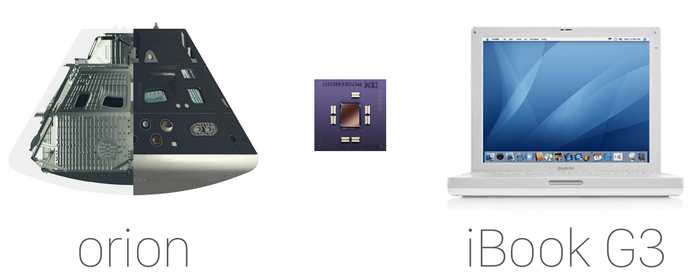現在アメリカのNASAが人類を火星に送り込むために開発を行っている宇宙船「Orion(オリオン)」ですが、このOrionにはAppleのiBook G3に採用されたIBM PowerPC 750FXが採用されているそうです。詳細は以下から。

Geek.comの記事”NASA’s Orion spacecraft runs on a 12 year-old single-core processor from the iBook G3“によると、今月5日 NASAは有人火星探査の為に導入する次世代宇宙船「Orion」の無人飛行に成功しましたが、このOrionには12年前iBook G3にも採用されていたIBM PowerPC 750FXが採用されていたそうです。
#Orion spacecraft is secured inside the well deck of @USSAnchorage. Thanks @USNavy! http://t.co/0B7c7doL9H
PowerPC chips haven’t been of any importance in consumer applications since Apple moved to the x86 architecture starting in 2005. Before that, PowerPC was at the heart of all Apple’s machines. In fact, some versions of the iBook G3 from 2003 ran the exact same chip being used in the Orion flight computer.
2002年に製造が開始されたPowerPC 750FXは最大周波数900MHzと現在のCPUと比べて高性能な部類ではありませんが、このPowerPC 750FXはボーイング787のシステムにも採用されており、NASAはこのCPUを「計算速度ではなく信頼性」で採用したそうです。
If you follow the state of space exploration, that fact might not surprise you at all. The name of the game in space is reliability, not speed. Bleeding edge hardware is great when you’re on Earth, but in space astronauts are completely reliant on technology for survival. Components have to be tested again and again, then hardened against every foreseeable circumstance to make for the safest flight possible. That’s why Orion’s flight computer is a clunky Honeywell console originally developed for use in Boeing airliners. Powering this beast is an IBM PowerPC 750FX, which first hit the market in 2002.
信頼性が必要な理由として、NASAが公式のYouTube動画で(2分50秒辺りから)重要なポイントとして上げている通り、Orionに搭載されているシステムは火星への往路で2度 ヴァン・アレン帯という地球を取り囲む放射線帯を通過しなければならず、この際に放射線の影響を受けてシステムがエラーを起こさない信頼性のあるシステムとして、OrionにはPowerPC 750FXベースのシステムを2つ搭載しているとしています。
The radiation question has been heavily considered over the course of Orion’s design. This craft is intended to take humans farther out in space than ever before, and radiation levels are known to be higher out there. In the event a reboot is required, there’s a second flight computer on Orion that can take over.
さらにこの2つの同じシステムはCPU共有し高速化のためではなく、完全に同じシステムが2つ動作しており、お互いにエラーチェックをし、どちらかのCPUが放射線が原因でエラーを出し再起動する間のバックアップ用として存在するそうです。

That’s not even the extent of the redundancy built into Orion’s computer system. Each flight computer has two PowerPC 750FX chips humming away, but they are not working collaboratively to speed up calculations.
Instead, NASA has them both running identical software to error-check each other. If the output of one of these CPUs doesn’t match the other (possibly due to radiation exposure), the system will stop and reboot.
ちなみに、このOrionが火星に向かうのは2020年以降になる予定だそうです。
関連リンク:
・Orion – NASA
・PowerPC 7xx – Wikipedia
・iBook – Wikipedia
2014年12月10日 17時28分:誤字修正しました、失礼いたしました。



コメント
学生の頃バイトしたお金で初めて買ったiBookが火星に行く気持ちだ…
PowerPC 750ベースのRAD750じゃないの?
>>2
航空機マニアとみたw
RAD 750は火星探査機キュリオシティに採用されたPPC 750ベースのBAE製で、
今回オリオンに採用されてるのはユニット名わからないけどPPC 750FXベースのHoneywell製だね。
ttp://sci.tea-nifty.com/blog/2012/08/cpurad750200mhz.html
ちなみにF-35戦闘機もPPC G4ベースのユニットを搭載してるし、
PPC 750CLは任天堂のWii Uも使われているよ。PPCまだまだ頑張ってるw
よし!
iBook G3の中古品買って、Orionって名前つけて……
放置しよう。
iBook G3ユーザーだった身には印象的な記事、ありがとうございます。
>さらにこの2つの同じシステムはCPU共有し高速化のためではなく、完全に動揺のシステムが2つ動作しており、
ドジっ子ですね。動揺してたら可愛いかもしれませんがちょっと不安(笑